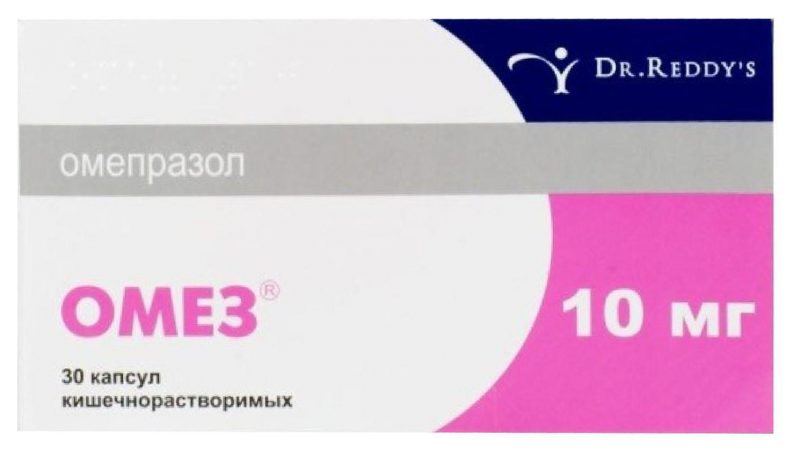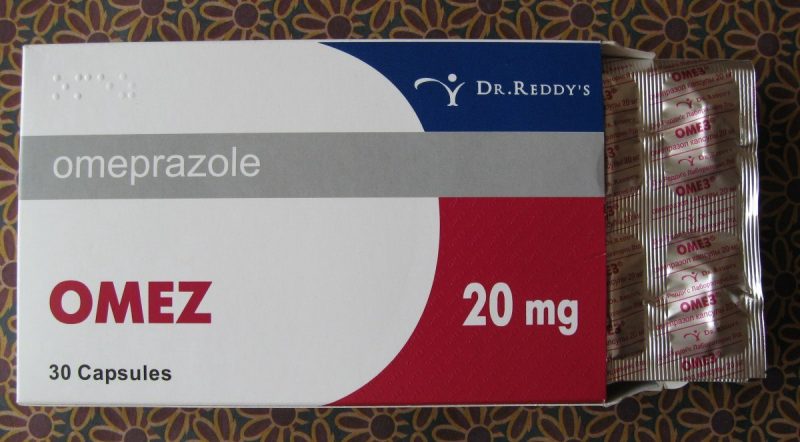Omez is an effective medicine for treating stomach ulcers. The action of the drug is aimed at inhibiting the production of gastric acid, which contributes to the rapid relief of the inflammatory reaction and pain in case of an ulcer. How to take Omez - it depends on the evidence. Before starting therapy with this drug, you should consult your doctor.
Material Content:
Composition and release forms
The main active ingredient is omeprazole. It belongs to the class of proton pump blockers. The antiulcer agent is available in three forms - capsules, ampoules and sachets. Enteric capsules contain 20 or 40 mg of active ingredient. They are available in packs of 10 and 30 capsules each.
The second form of release is ampoules. They contain the powder needed to prepare the solution. Each vial contains 40 mg of the active substance, the drug should be diluted with water for injection and administered intravenously.
Another form of release is sachets. The drug in this dosage form is presented in pharmacies under the commercial name Omez Insta. The contents of the bag are diluted in a small amount of water and taken orally. In each sachet - 20 mg of active ingredient.
- Note! Omez tablets are not available, the drug is presented only in capsules, vials and sachets.
The powder in the sachet is in demand due to the convenient form of reception and a pleasant mint aroma.
Pharmacological action and pharmacokinetics
The medicine belongs to the class of proton pump or proton pump inhibitors. These are drugs used in the treatment of acid-dependent gastrointestinal diseases.
The therapeutic effect of the drug is due to the ability of omeprazole to inhibit the secretion of gastric juice. Moreover, the active substance itself is a weak chemical compound that is active only in the acidic environment of intracellular tubules in parietal cells.
The choice of such a form of release as enteric-coated capsules provides the best transport of the active substance and high bioavailability of the drug, which reaches 65%. The main feature of omeprazole is its quick action. The maximum concentration of the active substance is observed 30-120 minutes after taking a therapeutic dose of the drug. The half-life of omeprazole is 1 hour, the active substance is rapidly metabolized by the kidneys and liver.
When taking the minimum therapeutic doses daily, maximum effectiveness is achieved on the fourth day. This is expressed in a 80% reduction in gastric acid secretion. 3-4 days after discontinuation of the drug, the secretory function of the gastrointestinal tract returns to normal.
Why is Omez prescribed?
Omez is an antiulcer drug designed to treat various diseases accompanied by an increase in the acidity of the stomach.
Indications for use:
- stomach ulcer;
- duodenal ulcer;
- reflux esophagitis;
- gastrinoma;
- drug gastropathy.
The drug should be taken with a recurring ulcer, and the medicine also helps with heartburn. Omez for gastritis should be prescribed by a doctor. The fact is that the drug will be effective only with high acidity of the stomach, therefore, before starting treatment, it is necessary to clarify the diagnosis. Omeprazole is often used in the treatment of gastritis, which occurs as a side effect against the background of long-term use of non-steroidal anti-inflammatory drugs (drug gastropathy).
The drug helps to reduce inflammation of the mucosa and eliminate pain in peptic ulcers of the gastrointestinal tract and intestines.
Moreover, the therapeutic effect is due to the effect on the very cause of discomfort - the high acidity of gastric juice.
How to take the drug?
The injection solution is used to exacerbate a stomach or intestinal ulcer with bleeding, which reduces the effectiveness of the encapsulated form of the drug. Usually, 40 mg of the drug is prescribed intravenously once a day for 3-4 days. After infusions, the patient is transferred to the drug in capsules.
The recommended initial dose of the drug is 20 mg or 1 capsule per day. With insufficient effectiveness, after a few days, you can double the dose, taking 40 mg of the drug. Usually, doctors prescribe medication once a day.
With peptic ulcer, the drug is prescribed for 3-4 weeks. This time is enough for the ulcer to begin to heal. In severe cases, the drug should be taken within 8 weeks.
People with a stomach ulcer or gastropathy are recommended to take 1 capsule (20 mg) of omeza per day during therapy with non-steroidal anti-inflammatory drugs. This reduces the risk of ulcer exacerbation.
The drug can be taken by children, but only as directed by a doctor.
Children with a body weight of more than 20 kg are prescribed 20 mg of the drug per day. Omez Insta is recommended, as a suspension is preferable for young children than large capsules that are difficult to swallow. The daily dosage is 1 sachet.
- Powder for the preparation of a suspension can be used to treat heartburn. In this case, a single dose of the drug an hour before meals is sufficient.
Many are interested in how to take the drug - before or after a meal. The official instruction for use recommends taking the drug in the morning half an hour before meals. Reception is carried out once a day.
During pregnancy and lactation
During pregnancy, the drug can be taken, since it does not affect the fetus. The drug passes into breast milk, but in small quantities, therefore, lactation is also not an absolute contraindication. The medicine is prescribed to pregnant women in standard therapeutic dosages.
During the bearing of the child, it is allowed to take only the encapsulated form of the drug.
Drug interaction
Omez reduces the acidity of the stomach, which may affect the pharmacokinetics of other drugs, the absorption of which depends on the acidic environment of the gastrointestinal tract.
The drug reduces the absorption of the following drugs:
- Ampicillin
- Ketoconazole;
- Itraconazole.
If you need to take these drugs with anti-ulcer capsules, you should consult your doctor about a change in dosage.
Omez increases the bioavailability of Diazepam, Phenytoin, so the dose of these drugs should be reduced.
Concomitant use with antacids is not contraindicated. Concomitant use of the drug with nelfinavir and atazanavir is prohibited.
Contraindications, side effects and overdose
Contraindications of drugs with omeprazole in the composition:
- intolerance to the active substance;
- chronic liver disease;
- acute renal failure;
- lactose intolerance (for encapsulated form).
For children, medicine is prescribed with caution and only by a doctor. Dosage adjustment in elderly patients is not required, except in cases of severe forms of renal failure.
In general, the drug is well tolerated and does not cause severe adverse reactions.
Possible negative reactions of the body:
- diarrhea;
- constipation;
- flatulence;
- dizziness;
- weakness;
- cephalgia;
- allergic reaction (skin rash and itching).
Intolerance to the drug is manifested by urticaria, angioedema, bronchospasm.
With the development of Quincke edema, urgent medical attention is needed.
When taking large doses of an antiulcer drug, an overdose is possible. Its symptoms: tachyarrhythmia, confusion, nausea, cephalgia. In this case, you need to call an ambulance at home. In case of an overdose, symptomatic therapy is practiced, since hemodialysis is ineffective.
Drug Analogs
It is not difficult to select analogues of the drug. Preparations with the same composition and dosage - Omeprazole, Proton, Diaprazole.
If you are intolerant of omeprazole, you should consult with your doctor about the appointment of a medicine from the same pharmacological group, but with a different active substance in the composition.
Most often, the following drugs are prescribed to replace Omezu:
- Barol;
- Rabeprazole;
- Dexylant;
- Nolpase;
- Pangastro.
Only an attending physician can choose an effective and safe analogue. It is recommended not to self-medicate and consult a specialist in a timely manner for advice.




















